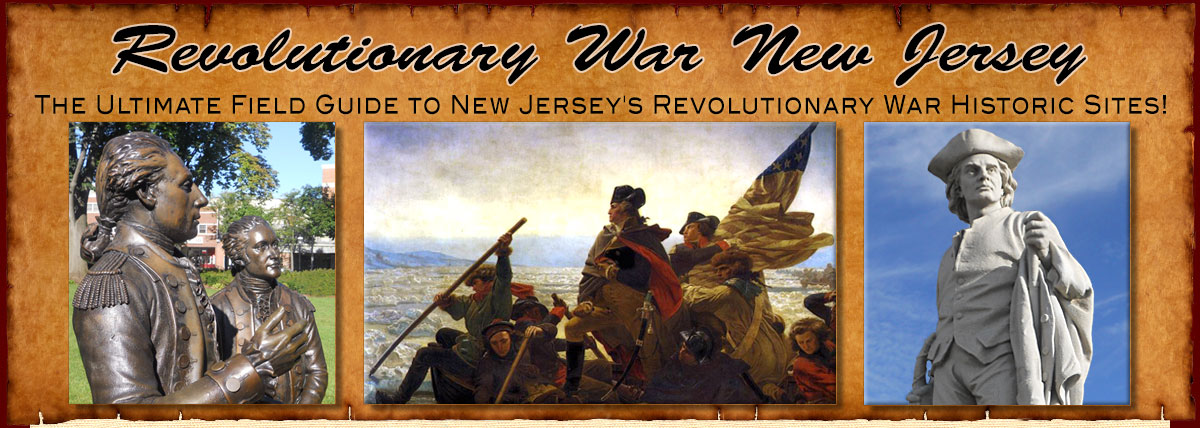

Sign on the Wallington side of the Passaic River.
The modern bridge at this location can be seen in the background of the photo on the left.
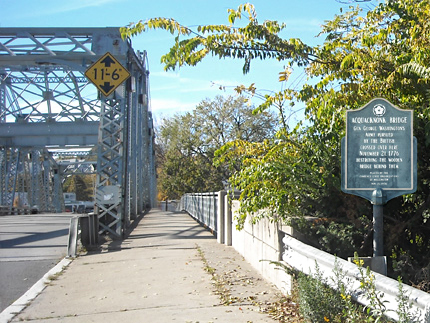
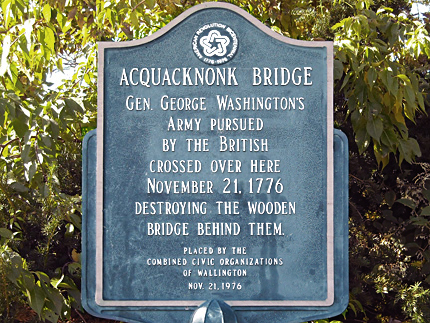
Sign located at the intersection of River Drive and Gregory Avenue, across River Drive from the modern bridge.
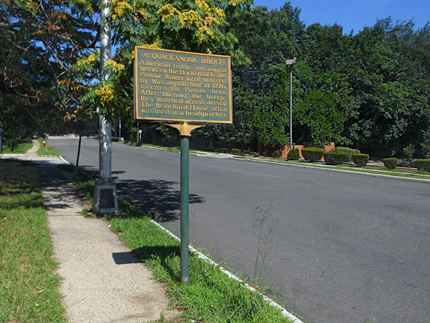
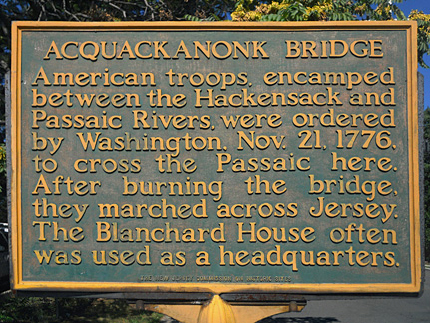
Sign located in Armory Park on Main Street
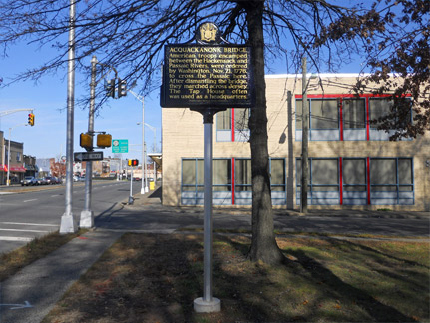
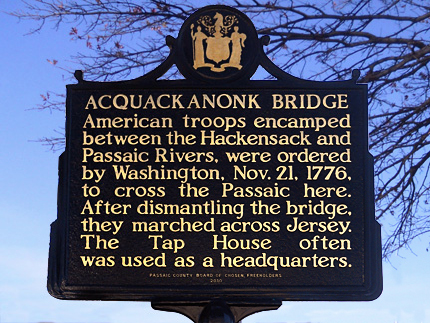
Acquackanonk Bridge Signs
• Gregory Ave. and River Dr.
• Armory Park at
Main Ave. and Prospect St.
Map / Directions to the Acquackanonk Bridge signs
Map / Directions to all Revolutionary War Sites in the city of Passaic
On the night of November 19-20, 1776, 5000 British and Hessian forces under General Cornwallis invaded New Jersey. They crossed over the Hudson River from New York City, disembarking about six miles north of Fort Lee at Lower Closter Landing, causing the Continental (American) Army to abandon their encampment at Fort Lee and begin a twelve-day retreat across New Jersey. (See the Fort Lee page for a detailed description of the events surrounding Fort Lee and the evacuation and retreat.)
On November 21, General George Washington and his retreating Continental Army reached the Passaic River, and crossed over the wooden Acquackanonk Bridge into Acquackanonk Landing, which is now the city of Passaic. At that time, it was the only bridge in the area to cross the Passaic River. To slow the British forces who were pursuing them, they destroyed the bridge behind them.
With the Acquackanonk Bridge destroyed, the pursuing British forces located a spot three miles away in what is now Garfield where the Passaic River could be forded. (A ford is the term for a shallow spot in a river where it can be crossed on foot or horseback.) However, the river was running high due to heavy rains, and they decided to wait several days for the water level to go down before finally crossing on November 27.
Meanwhile, the Continental Army continued its retreat across New Jersey. From here they moved along the west side of the Passaic River to Second River (now Belleville) and Newark, and then headed southwest toward Trenton. They arrived on December 2 in Trenton, where they spent five days moving all the troops and supplies across the Delaware River into Pennsylvania. Several weeks later, on Christmas night, they crossed back over the Delaware River and made a successful attack at the Battle of Trenton. [1]
The three signs pictured above are all located near a modern bridge which crosses the Passaic River at the site where the wooden bridge stood during the Revolutionary War. [2] The two signs in Passaic have identical text, except that one refers to the Blanchard House and the other to the Tap House. Both names refer to the same tavern, which is described in the entry below.

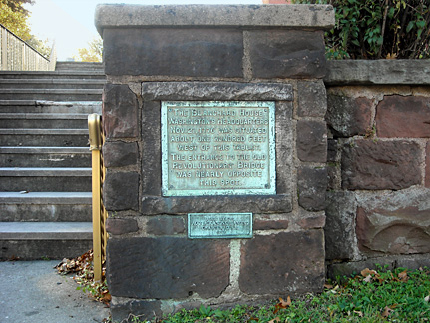
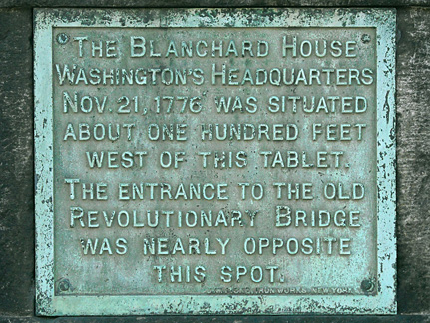
Blanchard House Site
126 River Dr.
Map / Directions to the Blanchard House Site
Map / Directions to all Revolutionary War Sites in the city of Passaic
This sign on the wall in front of the Saints Peter and Paul Church marks the site of the tavern called the Blanchard House (also known as the Tap House) which General George Washington is believed to have used as his headquarters on November 21, 1776.
There are several other Revolutionary War items on the grounds of the church, which are described below.
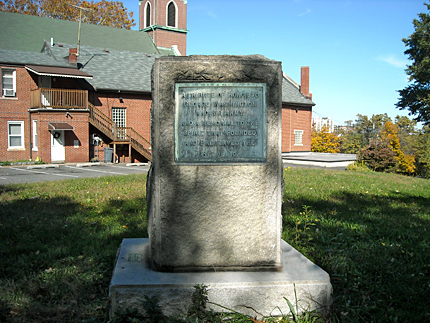
George Washington Monument
Walk up the stairs from the Blanchard House site marker to the south side of the Saint Peter and Paul Church to see this monument dedicated to George Washington. It was erected in 1901 with funds raised by the students of Passaic public schools. It originally stood about a half-mile south of here at the intersection of Aycrigg Ave. and Main Ave; it was moved here in 1930. [3]
Plaques on the monument contain the following text:
"A tribute of honor to George Washington and his army and a memorial to the spirit that founded and preserved the republic."
"Washington: Unique in Character ~ Blameless in Private Life & Public Office ~ Champion of Liberty ~ Friend of Man ~ Alone in Greatness ~ Honored by the World."
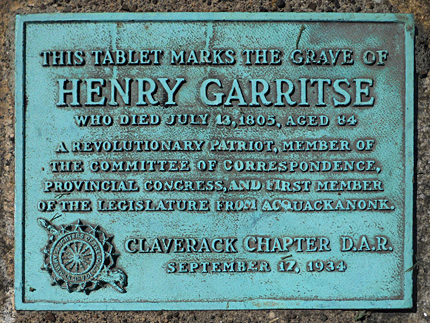
Henry Garritse Gravesite
A boulder monument on the north side of the church pays tribute to Henry Garritse, a resident of Acquackanonk who was prominent in Revolutionary War politics. [4]
The plaque lists the roles he played in representing Essex County during the Revolutionary War era. (What is now Passaic County was not created until 1837, fifty-four years after the end of the war. Acquackanonk was part of Essex County.) [5]
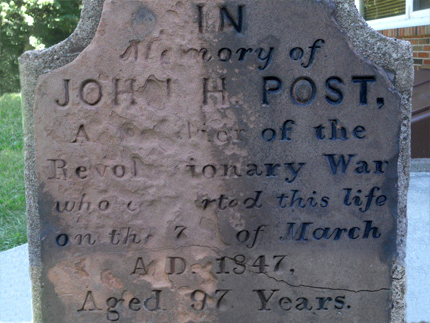
John H. Post Gravesite
The cemetery also contains the grave of John H. Post, who served as a private and as a corporal in the militia during the Revolutionary War. [6]
His gravestone and that of his wife Elizabeth Ackerman Post are mounted on a concrete post behind the church. The gravestones originally stood 75 feet to the northwest. [7]
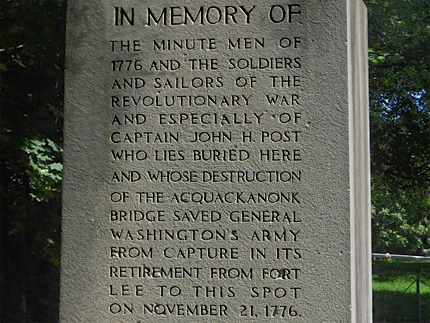
Tribute to Minute Men, Soldiers and Sailors Monument
A few yards from John H. Post's gravestones, there is a monument which pays tribute to the "minute men of 1776 and the soldiers and sailors of the Revolutionary War." It mentions John H. Post by name, in connection with the destruction of the Acquackanonk Bridge in November 1776. [8]
However, the story associating John H. Post with the destruction of the bridge is an incorrect bit of local lore that began appearing in print at the end of the 1800's. Post's own military pension application makes no mention of it, and in fact contradicts details of the bridge story. Also, the monument refers to him as "Captain John H. Post," but his pension application states that he did rise to the rank of corporal, but not to the much higher rank of captain. [9]

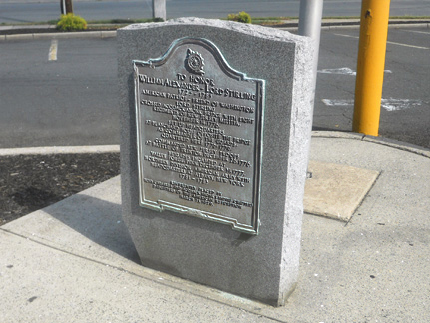
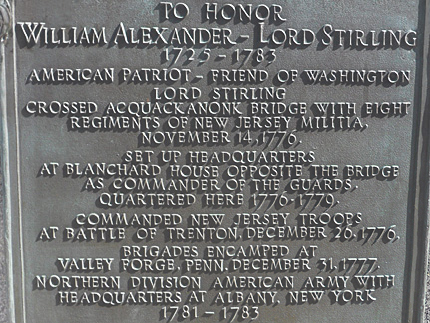
Lord Stirling Memorial
Across from the Acquackanonk Bridge, in the Burger King parking lot.
River Dr. and Gregory Ave.
Map / Directions to the Lord Stirling Memorial
Map / Directions to all Revolutionary War Sites in the city of Passaic
William Alexander, who served as a general in the Revolutionary War, was better known as Lord Stirling, a name he adopted because of his claim to have descended from Scottish nobility. He was born in New York City in 1726 and later moved to Basking Ridge, NJ.
Stirling began his Revolutionary War service as a colonel in the Somerset County Militia. He was later appointed Brigadier General and then Major General in the Continental Army. Lord Stirling was a close friend of George Washington, and one of his most trusted Generals.
In addition to his activity at Acquackanonk Landing commemorated in this memorial, [10] Lord Stirling took part in other important Revolutionary War events in New Jersey which have historic sites associated with them: [11]
• Christmas 1776 - Lord Stirling was part of the famous Crossing of the Delaware River
• December 26, 1776 - Fought at the Battle of Trenton
• June 26, 1777- Fought at the Battle of the Short Hills
• June 28, 1778 - Fought at the Battle of Monmouth
• Winter 1778-1779 - Headquartered at the Van Horne House in Bridgewater during the Second Middlebrook encampment
Lord Stirling died January 15, 1783, just months before the Treaty of Paris officially ended the Revolutionary War. He is buried in Manhattan in Trinity Church Cemetery, the same cemetery where Alexander Hamilton is buried.

1. ^ George Washington wrote the following letter to New Jersey governor William Livingston while at Acquackanonk Landing on November 21, 1776:
“From George Washington to William Livingston, 21 November 1776,” Founders Online, National Archives, last modified October 5, 2016, http://founders.archives.gov/documents/Washington/03-07-02-0138. [Original source: The Papers of George Washington, Revolutionary War Series, vol. 7, 21 October 1776–5 January 1777, ed. Philander D. Chase. Charlottesville: University Press of Virginia, 1997, pp. 195–196.]
~ For more information and accompanying source notes about the events in other towns mentioned in these four paragraphs, see the pages linked from within the text.
• See also:
David Hackett Fischer, Washington's Crossing (New York: Oxford University Press, 2004)2. ^ The sign on the Wallington side of the river was placed by the Combined Civic Organizations of Wallington, November 21, 1976.
The sign at Gregory Ave. and River Dr. was placed by the New Jersey Commission on Historic Sites.
The sign in Armory park was erected by the Passaic County Board of Chosen Freeholders in 2010, and is an exact replica of an earlier sign at this location which had been placed here in 1932. It is one of a series of signs from 1932 that were reproduced in 2010.
An article about this series of historic signs can be read at the NorthJersey.com website here.3. ^ One of the plaques on the monument states, "Erected May 30, 1901 by the pupils of the Passaic Public Schools with the generous assistance of their friends." Another small plaque on the base states, "Reset by the Acquackanonk Landing Chapter, D.A.R. 1930."
See also:
William W. Scott, History of Passaic and Its Environs, Volume I (New York and Chicago: Lewis Historical Publishing Company, Inc., 1922) Pages 215-216
Available to be read at the Internet Archive here4. ^ Garritse's service in the Committee of Correspondence, the New Jersey Assembly, and the Provincial Congress of New Jersey is recorded in:
Minutes of the Provincial Congress and the Council of Safety of the State of New Jersey (Trenton: Naar, Day & Naar, 1879) Pages 8, 63, 117, 169, 183, 282
Available to be read at the Internet Archive here5. ^ Passaic County was created in 1837 by "An act to erect part of the counties of Essex and Bergen into a new county to be called the county of Passaic; and the eastern part of the county of Gloucester into a separate county to be called the county of Atlantic."
See:
Minutes of Votes and Proceedings of the General Assembly of the State of New Jersey 1836-1837, Pages 269, 270, 316, 317, 333 and 359, at the New Jersey State Library website6. ^ NARA M804. Revolutionary War Pension and Bounty - Land Warrant Application Files - John H. Post
Obtained from Fold3.com7. ^ Information about site of the graves was drawn from a plaque on this small monument which was placed by the Passaic County Historical Society in November 1933.
8. ^ The other side of this monument pays tribute to the veterans of the Civil War and other wars. The monument's text states that was dedicated May 30, 1924.
9. ^ The story of Post's involvement with the destruction of the bridge appears to have first appeared in print in 1899 and then was repeated with embellishments in other books.
William J. Pape and William W. Scott, The News' History of Passaic: From the Earliest Settlement to the Present Day (Passaic: News Publishing Company, 1899) Page 56-57
Available to be read at Google Books hereWilliam Nelson, History of the City of Paterson and the County of Passaic, New Jersey (Paterson: Press Printing and Publishing Co., 1901) Page 144
Available to be read at the Internet Archive hereWilliam W. Scott, History of Passaic and Its Environs, Volume I (New York and Chicago: Lewis Historical Publishing Company, Inc., 1922) Pages 201-207
Available to be read at the Internet Archive hereJohn H. Post's own pension application, made in 1845, two years before his death, includes the details of his military service but makes no mention of the bridge incident. Other details included in the pension application contradict the three published versions of the bridge story listed above.
Post's pension application (NARA M804. Revolutionary War Pension and Bounty - Land Warrant Application Files) is available at Fold3.com10. ^ The following letters were written by Lord Stirling while at Acquackanonk Landing:
To George Washington from Major General Stirling, 4 October 1778,” Founders Online, National Archives, last modified October 5, 2016, http://founders.archives.gov/documents/Washington/03-17-02-0271. [Original source: The Papers of George Washington, Revolutionary War Series, vol. 17, 15 September–31 October 1778, ed. Philander D. Chase. Charlottesville: University of Virginia Press, 2008, pp. 259–260.]
“To George Washington from Major General Stirling, 5 October 1778,” Founders Online, National Archives, last modified October 5, 2016, http://founders.archives.gov/documents/Washington/03-17-02-0290. [Original source: The Papers of George Washington, Revolutionary War Series, vol. 17, 15 September–31 October 1778, ed. Philander D. Chase. Charlottesville: University of Virginia Press, 2008, pp. 276–277.]
“To George Washington from Major General Stirling, 6 October 1778,” Founders Online, National Archives, last modified October 5, 2016, http://founders.archives.gov/documents/Washington/03-17-02-0305. [Original source: The Papers of George Washington, Revolutionary War Series, vol. 17, 15 September–31 October 1778, ed. Philander D. Chase. Charlottesville: University of Virginia Press, 2008, p. 288.]
“To George Washington from Major General Stirling, 7 October 1778,” Founders Online, National Archives, last modified October 5, 2016, http://founders.archives.gov/documents/Washington/03-17-02-0318. [Original source: The Papers of George Washington, Revolutionary War Series, vol. 17, 15 September–31 October 1778, ed. Philander D. Chase. Charlottesville: University of Virginia Press, 2008, pp. 300–301.]
~ The plaque on the Lord Stirling Memorial states that it was placed by the Nova Caesarea and Acquackanonk Landing Chapters of the Daughters of the American Revolution on March 21, 1929.
11. ^ For more information and accompanying source notes about the events listed, see the pages linked from within the text.